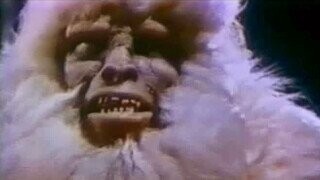The Horror Movie History of Bigfoot

Pop culture interpretations of sasquatches, or Fuzzywuzzium Biggusfooticii if you want to get technical, tend toward painting the creatures as loveable, family-friendly oafs – the occasional furry-themed holiday drug trip notwithstanding, of course. As evidence, look no further than both versions of Harry and the Hendersons; 2017's Belgian animated movie Son of Bigfoot and its sequel, Bigfoot Family, recently imported to Netflix; 2019's Missing Link; and even an episode of The Great North from, like, a month ago. There's even a whole song about how Bigfoot is a "childhood friend."
But that almost universal perception of a misunderstood but ultimately good-natured man-ape has been changing recently. Far from something to sit the kids down with, Hulu's new documentary Sasquatch purports that Bigfoot – or at least a Bigfoot – committed a grisly triple homicide in the pot fields of Northern California in 1993. Along with last year's Devolution, Max Brooks' novel about a "sasquatch massacre," and The Man Who Killed Hitler and Then the Bigfoot, the legendarily pacifist creatures are suddenly being regarded as the rampaging, man-eating stuff of therapy-necessitating nightmares. Seems like a crazy about-face, right?
Wrong. Bigfoot's been in the popular consciousness a lot longer than you might think and has a lengthy history of being a bone-crushing villain – most of recorded history, in fact.
Don't Miss
Several indigenous cultures have legends about dangerous "wild men" living in the woods; the word "sasquatch" is even said to be derived from a term from the Halkomelem tribe of British Columbia. Teddy Roosevelt – yes, that Teddy Roosevelt – published reports of violent interactions with Bigfeets starting in the 1880s, as did renowned naturalists in the 1920s.
The 1970s, meanwhile, were rife with low-budget horror movies turning Bigfoot into a low-budget murder monster. We're talking about classics like Bigfoot (1970), The Legend of Boggy Creek (1972), Creature from Black Lake (1976), and The Capture Of Bigfoot (1979). If you want to expand that into the realm of the sasquatches' snow-loving cousin the yeti, you've got Snowbeast (1977), Yeti (1977), and 1974's spectacularly titled Shriek of the Mutilated. And, if you're willing to look past the fact that I just said I was talking specifically about the '70s, there's also 1957's The Abominable Snowman, from Hammer Films and starring Grand Moff Tarkin and racism.
All of which is to say that Bigfoot being friendly is the real about-face, which is probably why we never got a Harry and the Hendersons II, or a fourth season of the TV show. They’d basically be snuff films.
Eirik Gumeny is the author of the Exponential Apocalypse series, a five-book saga of slacker superheroes, fart jokes, and assorted B-movie monsters, and he recently added werewolves and assassins to The Great Gatsby. He’s also on Twitter a bunch.
Top Image: Troma Entertainment